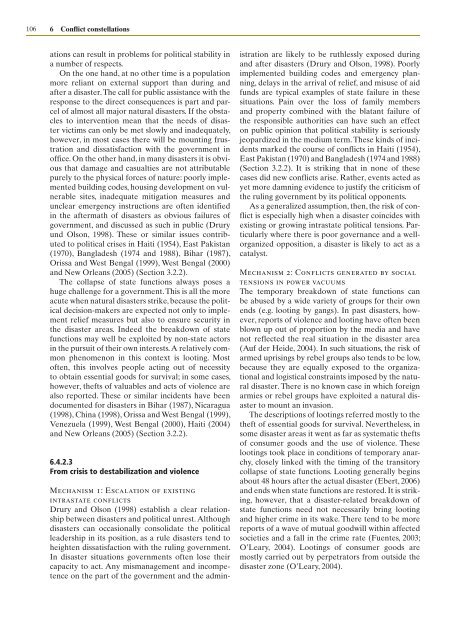World in Transition: Climate Change as a Security Risk - WBGU
World in Transition: Climate Change as a Security Risk - WBGU
World in Transition: Climate Change as a Security Risk - WBGU
You also want an ePaper? Increase the reach of your titles
YUMPU automatically turns print PDFs into web optimized ePapers that Google loves.
106<br />
6 Conflict constellations<br />
ations can result <strong>in</strong> problems for political stability <strong>in</strong><br />
a number of respects.<br />
On the one hand, at no other time is a population<br />
more reliant on external support than dur<strong>in</strong>g and<br />
after a dis<strong>as</strong>ter. The call for public <strong>as</strong>sistance with the<br />
response to the direct consequences is part and parcel<br />
of almost all major natural dis<strong>as</strong>ters. If the obstacles<br />
to <strong>in</strong>tervention mean that the needs of dis<strong>as</strong>ter<br />
victims can only be met slowly and <strong>in</strong>adequately,<br />
however, <strong>in</strong> most c<strong>as</strong>es there will be mount<strong>in</strong>g frustration<br />
and dissatisfaction with the government <strong>in</strong><br />
office. On the other hand, <strong>in</strong> many dis<strong>as</strong>ters it is obvious<br />
that damage and c<strong>as</strong>ualties are not attributable<br />
purely to the physical forces of nature: poorly implemented<br />
build<strong>in</strong>g codes, hous<strong>in</strong>g development on vulnerable<br />
sites, <strong>in</strong>adequate mitigation me<strong>as</strong>ures and<br />
unclear emergency <strong>in</strong>structions are often identified<br />
<strong>in</strong> the aftermath of dis<strong>as</strong>ters <strong>as</strong> obvious failures of<br />
government, and discussed <strong>as</strong> such <strong>in</strong> public (Drury<br />
und Olson, 1998). These or similar issues contributed<br />
to political crises <strong>in</strong> Haiti (1954), E<strong>as</strong>t Pakistan<br />
(1970), Bangladesh (1974 and 1988), Bihar (1987),<br />
Orissa and West Bengal (1999), West Bengal (2000)<br />
and New Orleans (2005) (Section 3.2.2).<br />
The collapse of state functions always poses a<br />
huge challenge for a government. This is all the more<br />
acute when natural dis<strong>as</strong>ters strike, because the political<br />
decision-makers are expected not only to implement<br />
relief me<strong>as</strong>ures but also to ensure security <strong>in</strong><br />
the dis<strong>as</strong>ter are<strong>as</strong>. Indeed the breakdown of state<br />
functions may well be exploited by non-state actors<br />
<strong>in</strong> the pursuit of their own <strong>in</strong>terests. A relatively common<br />
phenomenon <strong>in</strong> this context is loot<strong>in</strong>g. Most<br />
often, this <strong>in</strong>volves people act<strong>in</strong>g out of necessity<br />
to obta<strong>in</strong> essential goods for survival; <strong>in</strong> some c<strong>as</strong>es,<br />
however, thefts of valuables and acts of violence are<br />
also reported. These or similar <strong>in</strong>cidents have been<br />
documented for dis<strong>as</strong>ters <strong>in</strong> Bihar (1987), Nicaragua<br />
(1998), Ch<strong>in</strong>a (1998), Orissa and West Bengal (1999),<br />
Venezuela (1999), West Bengal (2000), Haiti (2004)<br />
and New Orleans (2005) (Section 3.2.2).<br />
6.4.2.3<br />
From crisis to destabilization and violence<br />
Mechanism 1: Escalation of exist<strong>in</strong>g<br />
<strong>in</strong>tr<strong>as</strong>tate conflicts<br />
Drury and Olson (1998) establish a clear relationship<br />
between dis<strong>as</strong>ters and political unrest. Although<br />
dis<strong>as</strong>ters can occ<strong>as</strong>ionally consolidate the political<br />
leadership <strong>in</strong> its position, <strong>as</strong> a rule dis<strong>as</strong>ters tend to<br />
heighten dissatisfaction with the rul<strong>in</strong>g government.<br />
In dis<strong>as</strong>ter situations governments often lose their<br />
capacity to act. Any mismanagement and <strong>in</strong>competence<br />
on the part of the government and the adm<strong>in</strong>-<br />
istration are likely to be ruthlessly exposed dur<strong>in</strong>g<br />
and after dis<strong>as</strong>ters (Drury and Olson, 1998). Poorly<br />
implemented build<strong>in</strong>g codes and emergency plann<strong>in</strong>g,<br />
delays <strong>in</strong> the arrival of relief, and misuse of aid<br />
funds are typical examples of state failure <strong>in</strong> these<br />
situations. Pa<strong>in</strong> over the loss of family members<br />
and property comb<strong>in</strong>ed with the blatant failure of<br />
the responsible authorities can have such an effect<br />
on public op<strong>in</strong>ion that political stability is seriously<br />
jeopardized <strong>in</strong> the medium term. These k<strong>in</strong>ds of <strong>in</strong>cidents<br />
marked the course of conflicts <strong>in</strong> Haiti (1954),<br />
E<strong>as</strong>t Pakistan (1970) and Bangladesh (1974 and 1988)<br />
(Section 3.2.2). It is strik<strong>in</strong>g that <strong>in</strong> none of these<br />
c<strong>as</strong>es did new conflicts arise. Rather, events acted <strong>as</strong><br />
yet more damn<strong>in</strong>g evidence to justify the criticism of<br />
the rul<strong>in</strong>g government by its political opponents.<br />
As a generalized <strong>as</strong>sumption, then, the risk of conflict<br />
is especially high when a dis<strong>as</strong>ter co<strong>in</strong>cides with<br />
exist<strong>in</strong>g or grow<strong>in</strong>g <strong>in</strong>tr<strong>as</strong>tate political tensions. Particularly<br />
where there is poor governance and a wellorganized<br />
opposition, a dis<strong>as</strong>ter is likely to act <strong>as</strong> a<br />
catalyst.<br />
Mechanism 2: Conflicts generated by social<br />
tensions <strong>in</strong> power vacuums<br />
The temporary breakdown of state functions can<br />
be abused by a wide variety of groups for their own<br />
ends (e.g. loot<strong>in</strong>g by gangs). In p<strong>as</strong>t dis<strong>as</strong>ters, however,<br />
reports of violence and loot<strong>in</strong>g have often been<br />
blown up out of proportion by the media and have<br />
not reflected the real situation <strong>in</strong> the dis<strong>as</strong>ter area<br />
(Auf der Heide, 2004). In such situations, the risk of<br />
armed upris<strong>in</strong>gs by rebel groups also tends to be low,<br />
because they are equally exposed to the organizational<br />
and logistical constra<strong>in</strong>ts imposed by the natural<br />
dis<strong>as</strong>ter. There is no known c<strong>as</strong>e <strong>in</strong> which foreign<br />
armies or rebel groups have exploited a natural dis<strong>as</strong>ter<br />
to mount an <strong>in</strong>v<strong>as</strong>ion.<br />
The descriptions of loot<strong>in</strong>gs referred mostly to the<br />
theft of essential goods for survival. Nevertheless, <strong>in</strong><br />
some dis<strong>as</strong>ter are<strong>as</strong> it went <strong>as</strong> far <strong>as</strong> systematic thefts<br />
of consumer goods and the use of violence. These<br />
loot<strong>in</strong>gs took place <strong>in</strong> conditions of temporary anarchy,<br />
closely l<strong>in</strong>ked with the tim<strong>in</strong>g of the transitory<br />
collapse of state functions. Loot<strong>in</strong>g generally beg<strong>in</strong>s<br />
about 48 hours after the actual dis<strong>as</strong>ter (Ebert, 2006)<br />
and ends when state functions are restored. It is strik<strong>in</strong>g,<br />
however, that a dis<strong>as</strong>ter-related breakdown of<br />
state functions need not necessarily br<strong>in</strong>g loot<strong>in</strong>g<br />
and higher crime <strong>in</strong> its wake. There tend to be more<br />
reports of a wave of mutual goodwill with<strong>in</strong> affected<br />
societies and a fall <strong>in</strong> the crime rate (Fuentes, 2003;<br />
O’Leary, 2004). Loot<strong>in</strong>gs of consumer goods are<br />
mostly carried out by perpetrators from outside the<br />
dis<strong>as</strong>ter zone (O’Leary, 2004).
















